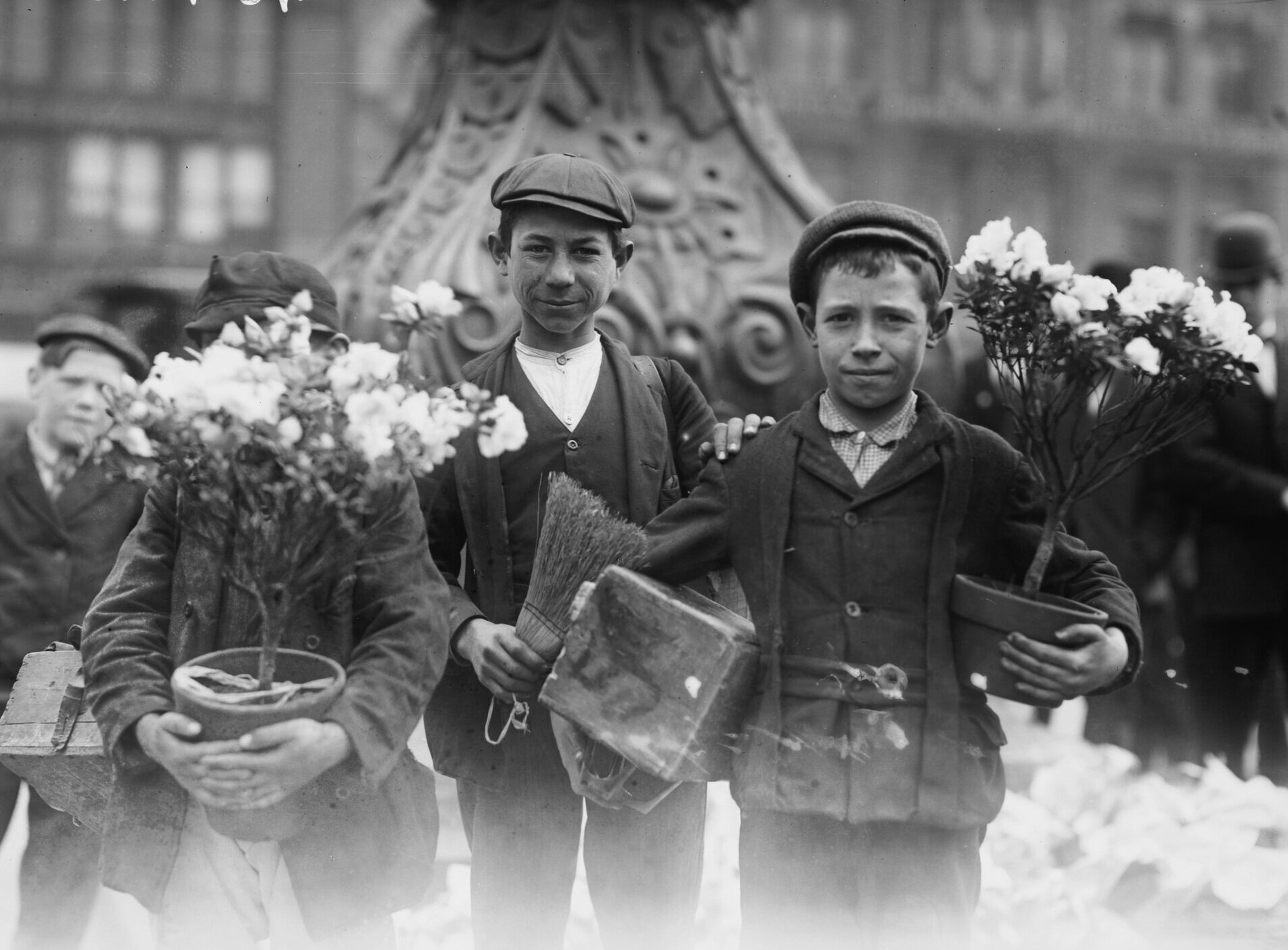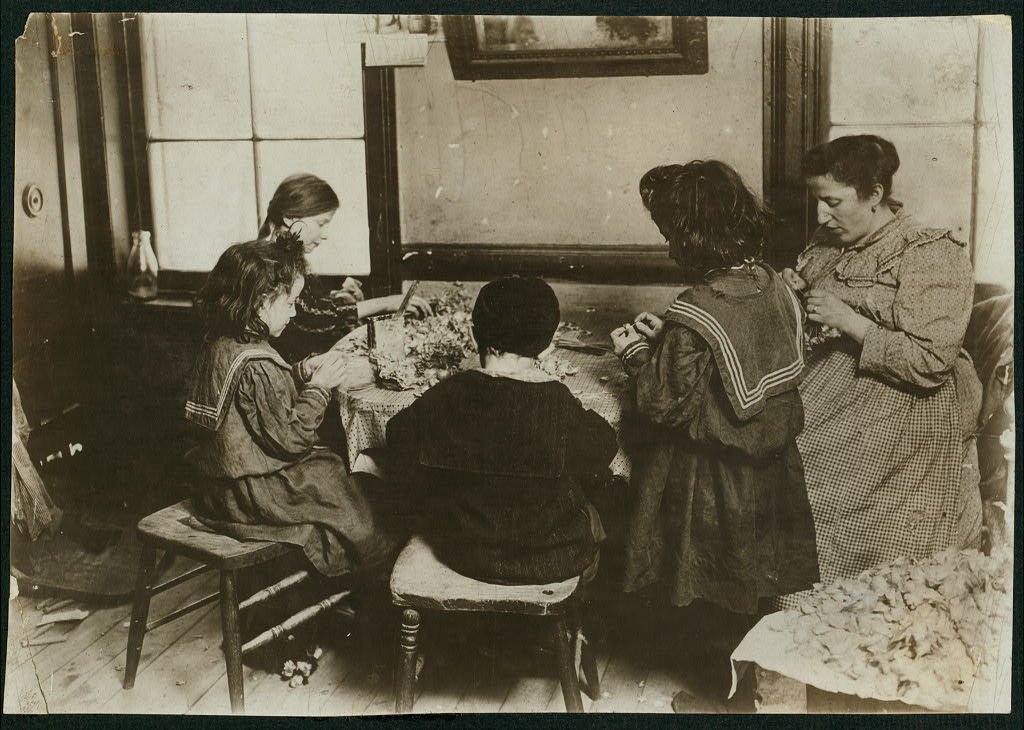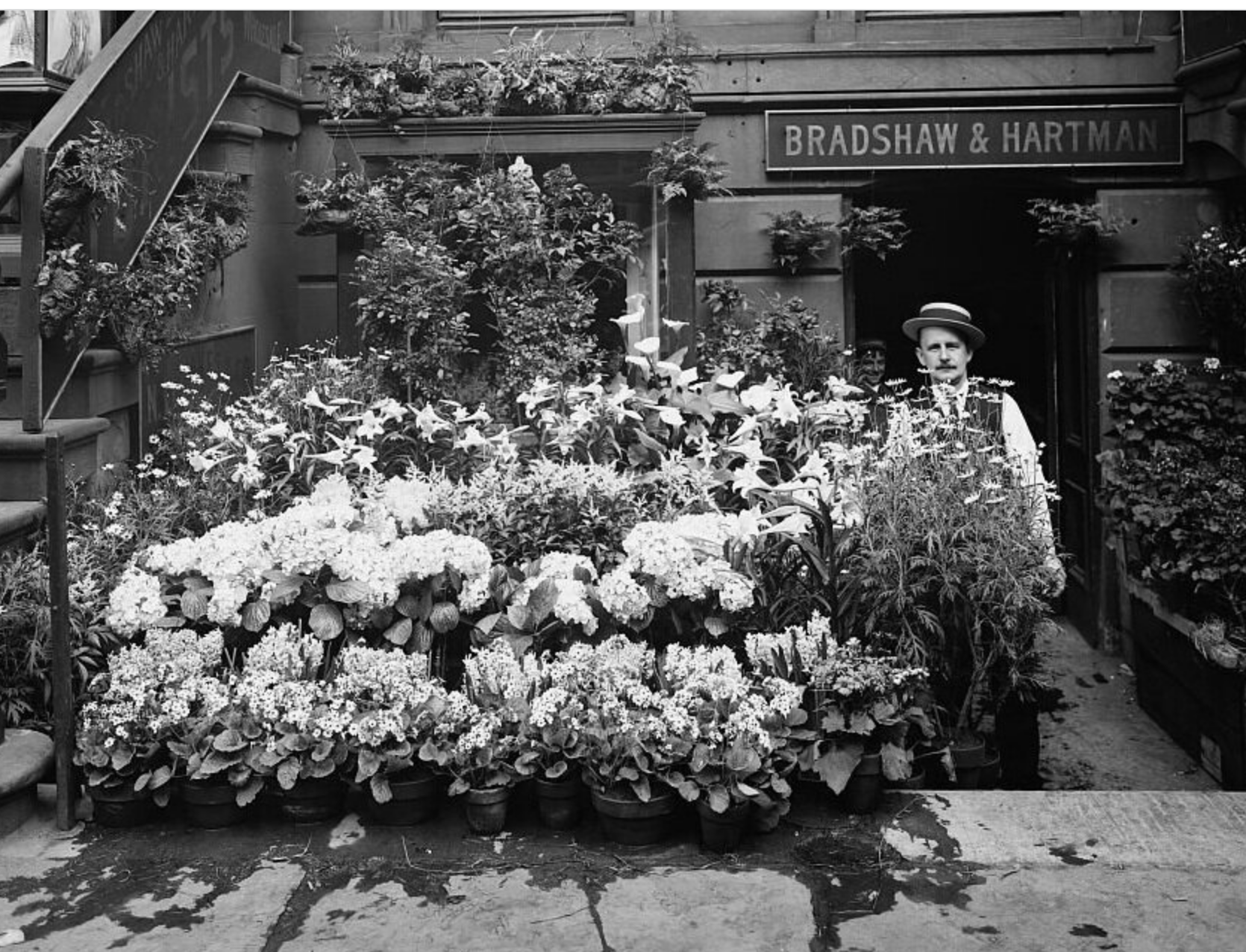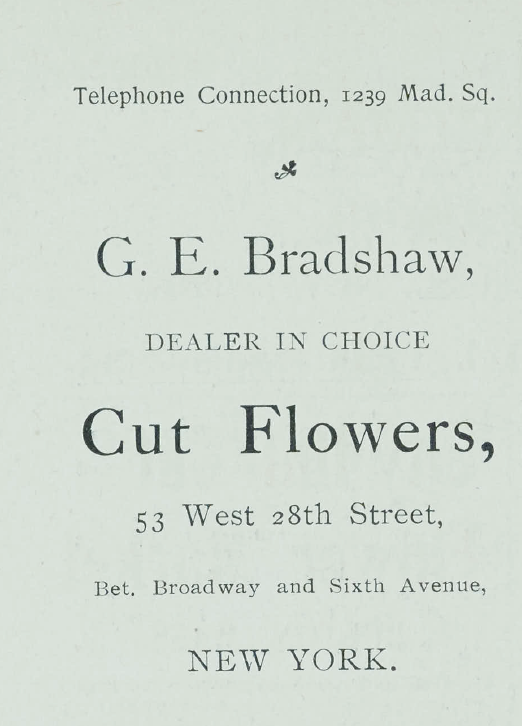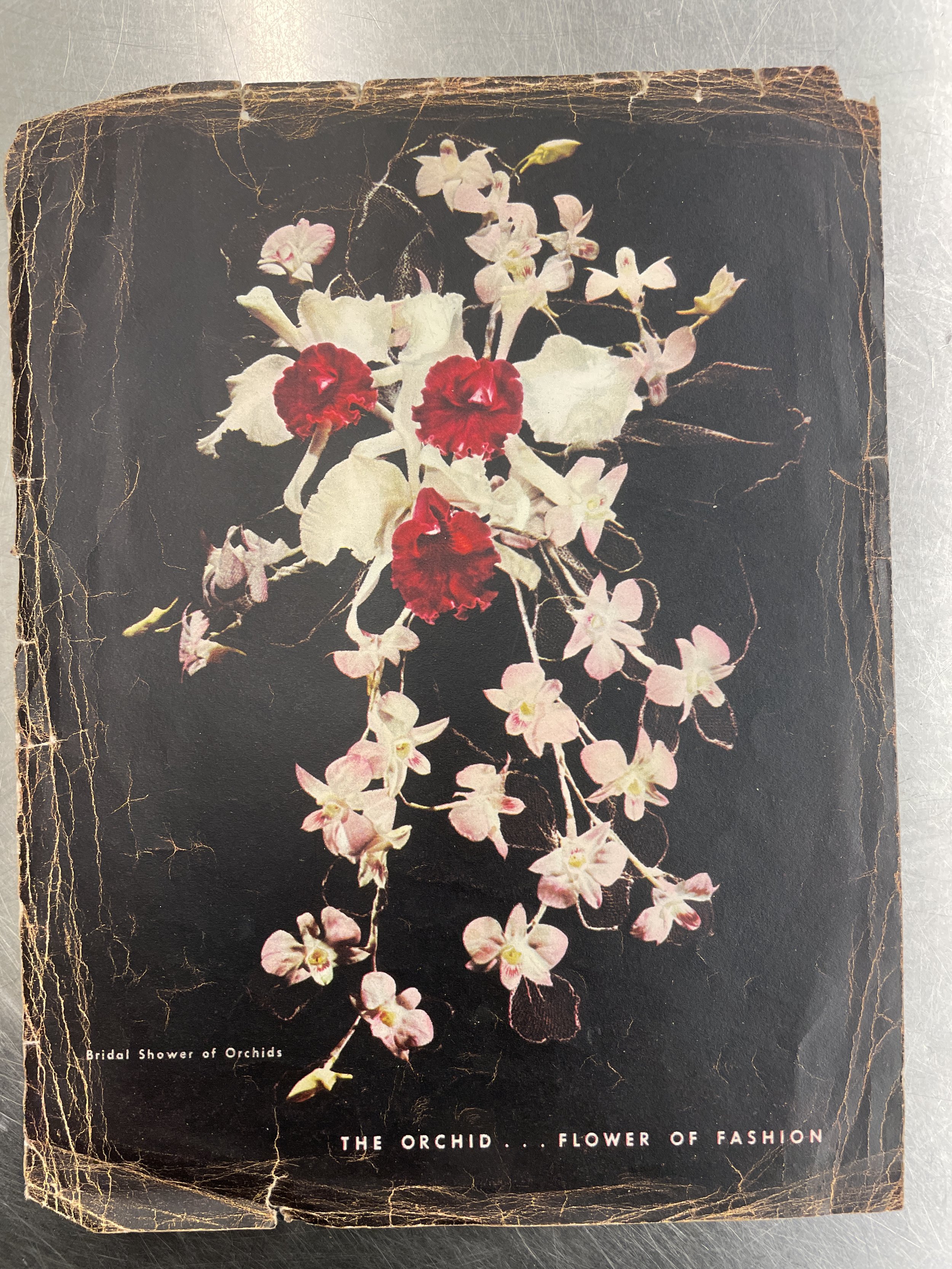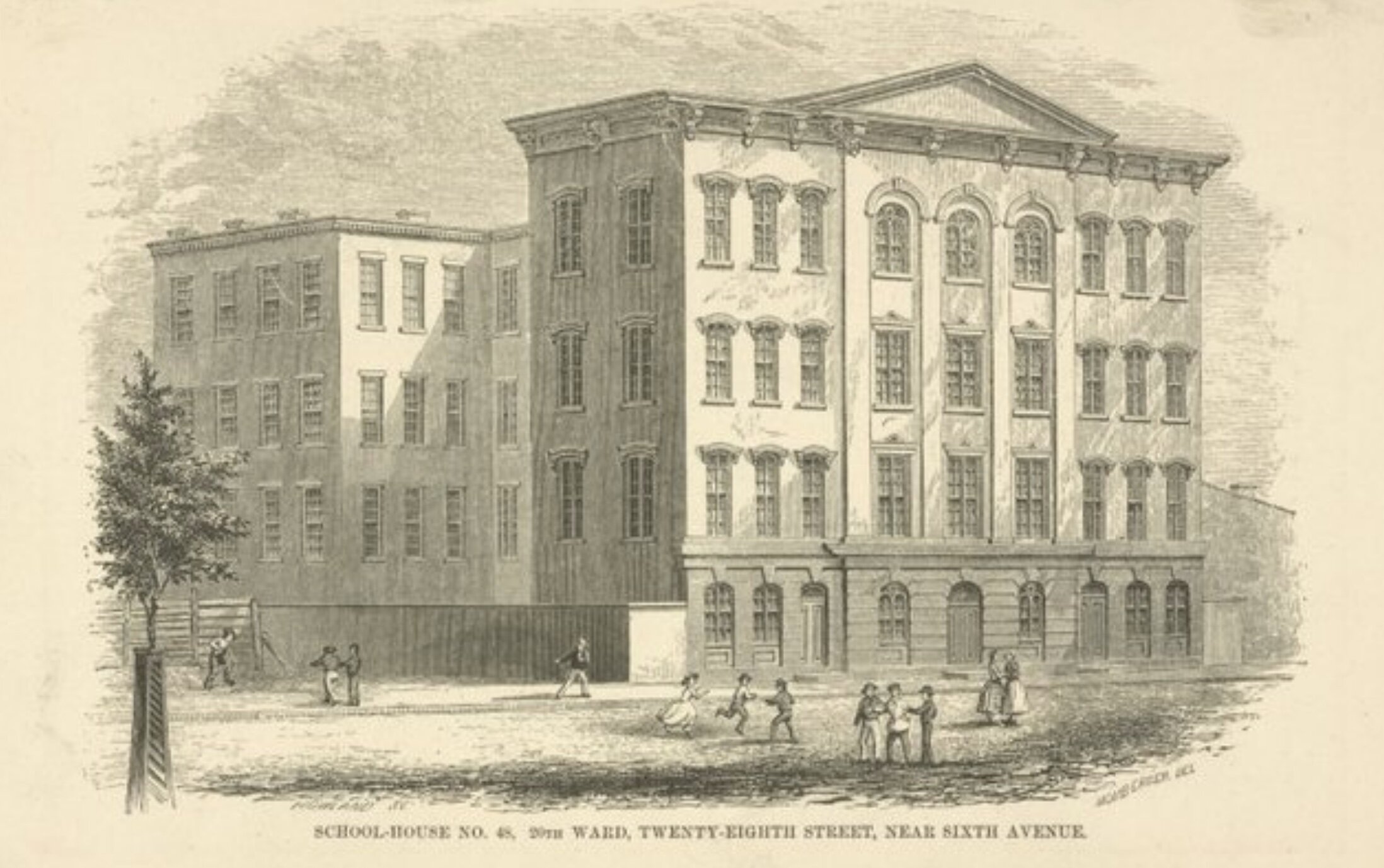Our History
Vibrant Beginnings
New York City has always had a lively trade in flowers. In the early days, farmers would sell flowers alongside produce in venues like the West Canal Street market, which extended from Washington Street to Fulton to Chambers Streets. It wasn’t until the beginning of the 1850s that floral districts sprouted up, with the creation of the West Canal Street Floral Market. In the decades following the Civil War, the city grew in riches and population; more buildings were constructed , taking away the land available for markets. Hence, the Union Square Flower Market was born.
Canal Street Floral Market, Left and above, 1871.
Flowers were essential to every day life in early city history. New York had severe odor issues during the mid-1800s due to poor sanitation. During this time, people would say they could smell Manhattan 3 miles away. So having fresh flowers in their homes masked the scent from the fetid streets. Similarly, restaurants would use flowers at tables to mask their clients body scent due to lack of good hygiene.
(Above, 1880s Canal Street Flower Market) During these years, there was no way to order flowers in advance. One could only show up at the market and see what the vendor had gotten to sell from a nursery or garden. During this time, getting fresh cut flowers was especially a luxury—they wouldn't last that long and were hard to maintain since there was no refrigeration. For this reason, potted plants were extremely popular. But they, too, were seasonal, and weather also affected availability.
(Above, c. 1900 at Union Square Park. Selling Azalea, Chrysanthemums, Hydrangeas and Daisy plants.)
UNION SQUARE FLOWER MARKET
The Union Square Flower Market was established on Saturday, April 11th 1891. They sold plants and some cut flowers. From the 1870s through 1930, Manhattan was transforming. Buildings were going up fast, businesses moved in, and the economic engine grew. The floral market was competitive; florists went to court over who had dibs on the corner spot.
By 1900, there were 237 greenhouses growing flowers in New York State. This increased the variety of flowers sold at the Union Square market, and brought down the cost. Roses sold for $1 a dozen, Azalea plants started at $3.50 each, and potted Boston ferns sold for $1. Most flowers came from local farms in Long Island, rural New York State counties, and New Jersey.
During the late 1800s and early 1900s, florist clubs & associations had emerged, allowing them to order in larger shipments. This helped florists to reach greenhouses and nurseries far away as Massachusetts, Kentucky, Kansas, Illinois and Florida. The floral business was booming.
Above, Union Square Flower Market. Hydrangeas, hyacinth and Azalea plants for sale.
C. 1900 at Union Square Park Floral Market. Young boys looking for work. They would earn a couple of pennies for floral delivery. They were also ready to give a nickel shoe shine if the opportunity presented itself. The potted azaleas were $3.50 each.
Union Square Flower Market, c. 1900
Many organizations used flowers during the Spring to raise money. Around 1916, the Women’s Suffragist Movement sold flowers, which they purchased at the Union Square Floral Market, from cars as they drove around the city.
Around 1916, the Women’s Suffragist Movement
In the late 1890s, wholesale cut flower companies gradually began relocating to the 28th Street and its surrounding areas in New York . The New
York Florist Club headquarters, located nearby on 23rd Street, played a pivotal role in this migration by influencing florists to move their businesses to the area . It was during this time that George E . Bradshaw and John R . Hartman established one of the very first Wholesale Florists company in 1891, setting up shop at 53 West 28th Street . His shop is shown at right .
By the 1920s, the vibrant cultural centers of the floral district and Tin Pan Alley had taken root in New York City. This historic photograph captures a westward view from Broadway on 28th Street, where many of the buildings still stand today. The bustling streets were filled with the sounds of elevated trains and motorcars, while the charming flower boxes on the sidewalks.
Some florists got very creative in their marketing campaigns!
119-121 West 23rd street, Headquarters of the New York Cut Flowers. C.1900
During the mid-1800s, Long Island's floral farms and nurseries played a pivotal role in supplying a significant portion of cut flowers and plants to both wholesale and retail companies. These delicate blooms were meticulously packed in wooden crates and preserved with ice until the early 1960s. They embarked on a journey via ferry from Long Island City to the bustling piers at East 34th Street, where a vibrant flower market awaited the florists. With 150 stand holders and an additional 50 stands available for rent, the market thrived, supported by 15 commission men who facilitated orders. Entry fees and charges were customary for securing selling spots in this bustling marketplace.
The growth of the cut flower industry owes its origins to the introduction of year-long greenhouses in the mid to late 1800s. These innovative structures revolutionized the industry, allowing florists to cultivate flowers throughout the year. Advancements in heating technology further extended the availability of fresh blooms, resulting in an impressive variety of floral offerings.
At the heart of this flourishing trade was the New York Cut Flower Commission, an essential group of growers. This commission played a vital role in ensuring the smooth sale and distribution of fresh flowers to wholesale companies. Their coordination and expertise ensured a seamless process from the growers to the eager hands of wholesale buyers.
In 1875, the headquarters of the New York Cut Flower Commission stood proudly at 119-121 West 23rd Street in the bustling city of New York. The flower industry thrived during this period, with numerous growers and sellers actively participating in the trade, making the city a bustling center for floral commerce.
The Cut Flower Exchange emerged as a vibrant hub for the trade of cut flowers between wholesale and retail companies. In the 1870s, it reported an impressive average annual sales figure of $96,000, equivalent to approximately $3,419,085.71 in today's currency.
Simultaneously, Boston's floral market engaged in trade with wholesale companies in New York City. The primary wholesale area extended from 23rd to 30th Street, nestled between Broadway and Sixth Avenue. The late 1900s witnessed an annual trade volume of $2,500,000, which in today's terms would amount to approximately $89,038,690.48.
In 1891, the New York Cut Flower Company transformed into the Cut Flower Exchange, relocating from its previous address at 404-412 East 34th Street. It found its new home in the Coogan Building at 776 6th Avenue on 26th Street, where it would thrive for the next six decades. Each morning, the ringing of a bell would signal the opening of the market, inviting retail florists and floral peddlers into the bustling space. By the 1940s, West 28th Street gradually emerged as the vibrant floral district, benefiting from the patronage of affluent clients who flocked to the area to purchase luxurious fur coats. This surge in foot traffic translated into increased sales for florists and wholesale companies in the vicinity. Throughout the 1930s and 1940s, West 28th Street and its surrounding area solidified their position as the central hub where florists procured flowers from wholesale companies, further enhancing the vibrancy and allure of the floral industry in the city.
Coogan Building 26th & 6th Avenue. From 1903-1950s This was the site of the site were all the Cut Flower wholesale company sold flowers only to Florist. Not the public.
Vintage Advertisements from 1900: Wholesale Cut Flower Companies
Wholesale Cut Flower Protective Association 1949 annual dinner at the Plaza Hotel. These were all the whole companies in the Flower District of New York. Photo credit: Superior Florist Shop, Louis Rosenberg was a member at the time.
During the late 50s-60s 28th Street became the official Floral district in New York. Over 50 wholesale companies and many supply shops.
Report shows during the 1950s the floral District was the biggest in the states.
C. 1940s, View on 6th Avenue, SW corner. During the 1950s, wholesalers would have ice boxes to keep the flowers fresh. They would receive 5 large blocks of ice (at $3.50 ea.) which would last a month. This cooling technique was used until the 1960s.
2021, View on 6th Avenue, SW corner. George Rallis Inc. (est. 1954), US Evergreen Inc. (est. 1983) and International Garden Inc. (est. 1980)
C.1940s, 106 West 28th Street
2021, 106 West 28th Street. Noble Plant and Tropical Plants & Orchids
C. 1940s, Cut Rates Flower at 131 West 28th Street, and a fur company at 129 West 28th Street. This block was known for flowers and furs between until the 1980s.
Associated Cut Flowers At 131 West 28th Street and the Hayden Hotel at 127 West 28th. Today, many of the buildings in the district that housed florists and wholesalers are being demolished, with luxury hotels and residential buildings being constructed in their places. This development, although perhaps of some economic benefit to the city, has slowly shrunk the flower market.
In 1854, prior to the arrival of the fur and floral businesses, a school was constructed at 120 West 28th Street. “Schoolhouse no. 48” was one of the oldest public school buildings in the city.
During the 1930s, the block around the school transformed to house fur businesses, garment stores, saloons, florists and floral wholesale companies.
Today, the ground floor of 120 West 28th Street is the home for wholesalers G.Page Wholesale Flowers, Caribbean Cuts, AbraFlora, and Foliage Garden Plants. The upper floors of the school building are now mainly rented out to floral designers for their production studios.





